Tree peonies: variety names, planting and care
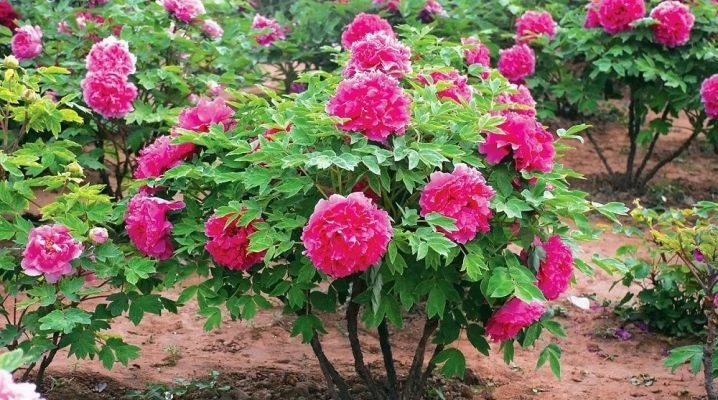
The tree peony is the most beautiful garden plant and is actively used in landscape design. It is the closest relative of the herbaceous peony and is in no way inferior to it in its decorative characteristics.
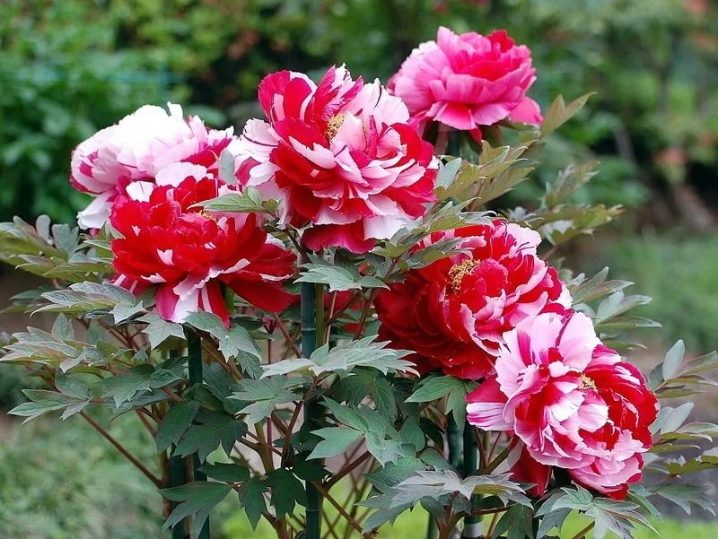
Peculiarities
Tree peonies are deciduous shrubs that often grow up to 1.5-2 meters. Plants are characterized by erect, pale brown stems that grow thicker and stronger every year.
Cirrus leaves have an openwork shape and look very unusual. Flowers are located at the ends of the shoots and reach a diameter of 12-20 cm. They are of double, semi-double and simple type and have a very wide color palette. The color of the flowers can be very different, ranging from bright white to pale green, blue and purple shades.
Moreover, among the huge variety of varieties, there are also very interesting two-color specimens. The petals of these colors have a gradient, when one shade smoothly passes into another. A characteristic feature of tree peonies is the increase in the number of flowers over time. As a result, an adult bush is a bright blooming ball, which often becomes the main decoration of a summer cottage.
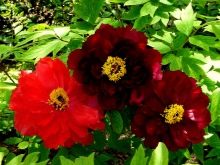
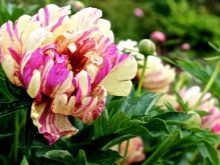
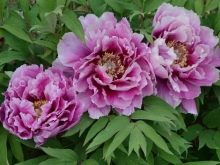
At the same time, 70 flowers can be present on one bush, while the flowering phase of each of them is from 8 to 10 days. Due to the large volume of the bush, the peony is recommended to be planted separately from other garden species or at some distance from them.
It looks very good both in group and in single plantings, and is able to decorate the local area, a place near the garden bench or the entrance to the house.


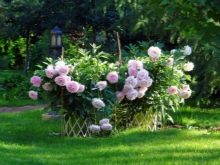
How is it different from a herbaceous peony?
The first difference between tree and herbaceous peonies is their appearance. So, the latter is a classic garden flower of small size, while the former is actually a shrub with powerful lignified shoots and a developed root system. In addition, in herbaceous peonies, at the onset of the first cold weather, the stems with shoots die off, while the shrub type grows them from year to year and turns into a large two-meter bush. In the autumn months, it sheds its leaves, and its young stems begin to woody.
The next difference between tree and herbaceous peonies is that the shrub does not need to be cut to stimulate future flowering. It perfectly tolerates winter in the middle zone of our country, including in the Volga region and the Moscow region, and does not need additional shelter. Another difference is that tree-like forms bloom in late May - early June, while herbaceous forms only by mid-June.
Peonies also differ in the lifespan of adults. The tree type is the leader here. There are many cases when a plant without transplanting grew in one place for over 50 years, while herbaceous perennials live much less.

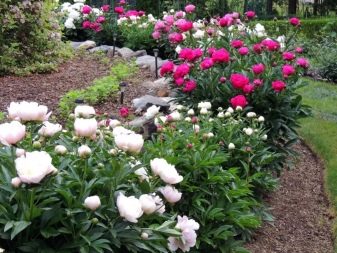
The next difference is the timing of the first flowering. And if herbaceous species are able to bloom as early as the next season after planting, then tree forms need 4-5 years for this. First, single flowers appear at the ends of the shoots, and then, over several seasons, the bush grows shoots and is actively covered with buds.
Varieties
A significant part of the tree peony varieties are bred in China. Several species were taken as a basis, which were used as parents. Based on belonging to a particular species, the varieties are divided into three large groups: Sino-European, Japanese and hybrid. They differ in the shape, size and color of flowers, as well as the structure and color of the leaves.
Below is a brief overview of the varieties that are most often mentioned on horticultural forums, which means they are the most popular.
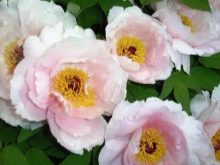
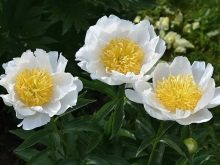
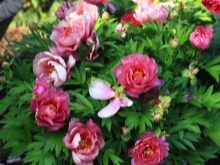
"Red giant"
Tree peony "Red giant" is distinguished by short stems and upright growing red flowers. An adult plant is characterized by vigorous growth and very abundant flowering.
The variety has large beautiful leaves and looks good both in single plantings and in compositions.
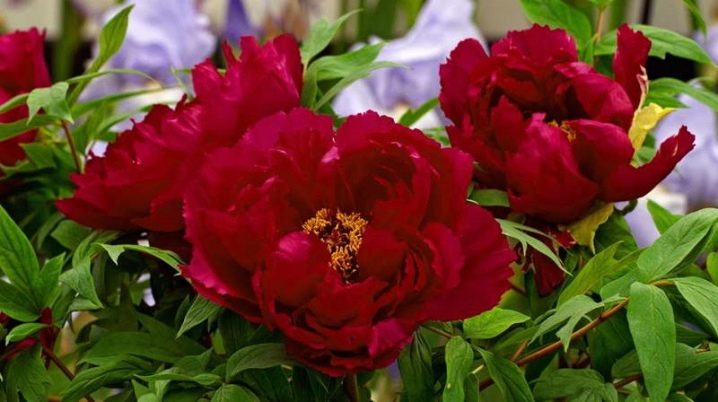
"Kinko"
Peony "Kinko" is a tree-like shrub with unusual golden crown-shaped flowers with a spectacular bright red edging and reaching a diameter of 17 cm. The plant is distinguished by abundant flowering and, when favorable conditions are created, it grows up to 1.5 meters. "Kinko" is quite undemanding to the composition and quality of the soil, but it feels better on alkaline fertile soils.
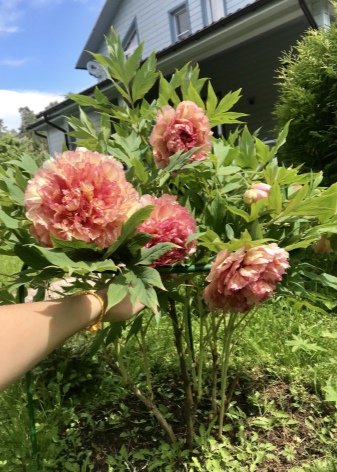
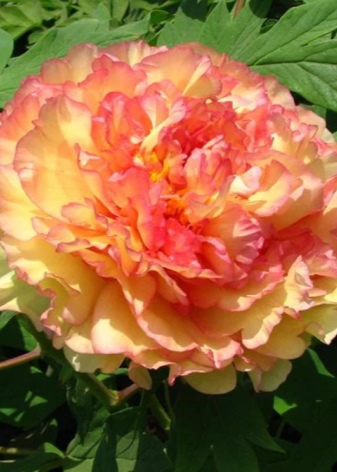
"Blue Sapphire"
Peony "Blue Sapphire" is distinguished by beautiful bluish-pinkish buds covered with dark purple spots. The plant grows very quickly and is perhaps the most beautiful blue variety. The bush begins to bloom closer to the middle of the season and exudes a pleasant delicate aroma.
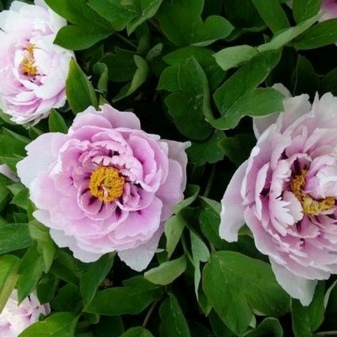
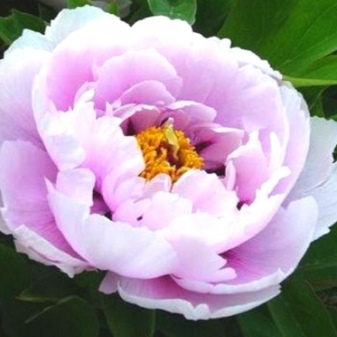
"Green beans"
The variety "Green beans" got its name from the soft green double flowers, which have corrugated wavy shapes and densely cover the entire bush. The plant is a late flowering species and smells very tasty during flowering.
The flower loves well-lit areas and loose, well-fertilized soil.
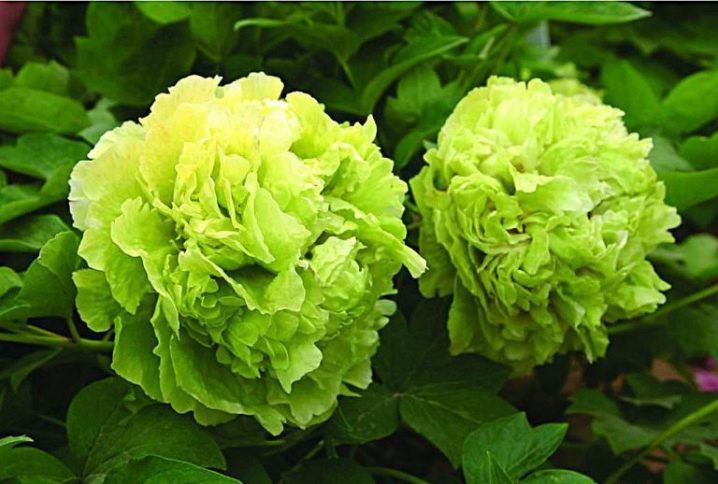
"Green ball"
Variety "Green ball" is distinguished by soft green terry spherical buds, which, when blooming, change their color to pink. Peony is characterized fairly late flowering, and the diameter of the blossoming flowers is 17-18 cm. The plant has thickened erect stems and belongs to tall species.
Under optimal conditions, the bush can grow up to two meters.
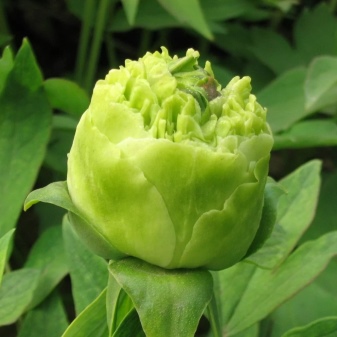
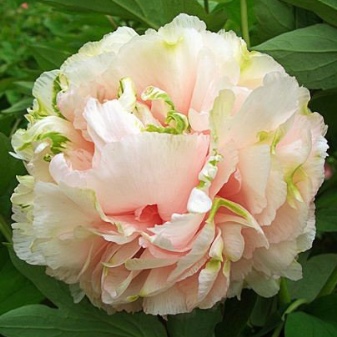
"Secret Passion"
Peony "Secret Passion" is a medium-sized shrub with bright purple-red buds. The flowers are slightly hidden in dense foliage, effectively combined with bright greenery. The plant is distinguished by very abundant early flowering and is quite resistant to infectious diseases.


"Smell of Lily"
The Smell of Lily variety has snow-white flowers with shiny petals and is tall. The peony develops very vigorously and bushes well.
The plant is characterized by an early lush flowering and looks good in compositions with deciduous and coniferous species.
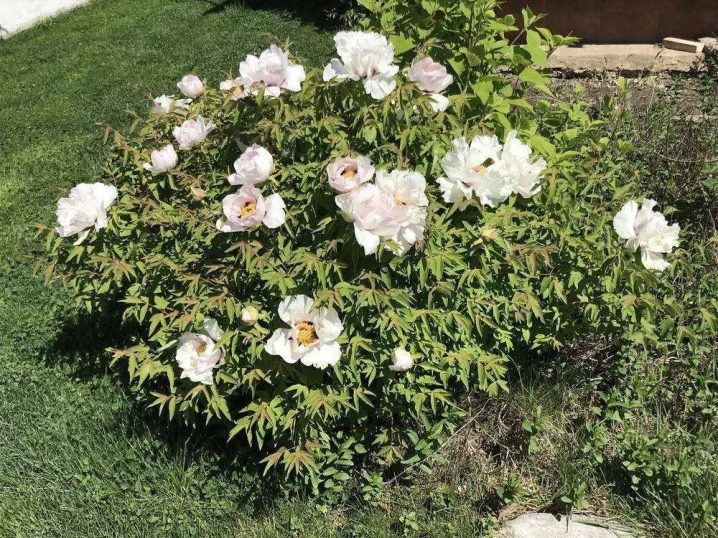
"Giant from Chemoza"
Peony "Giant from Chemoza" is a tall shrub, strewn with many light red flowers. The buds are crown-shaped and reach a diameter of 16 cm. The variety blooms quite late, has large foliage and is often used in group plantings and as a hedge.
The plant is resistant to many flower diseases and tolerates pest attacks well.


"Scarlet Sails"
Tree peony "Scarlet Sails" is distinguished by purple-red crown flowers, reaching a diameter of 16 cm. The plant blooms very early and exudes a subtle aroma.... An adult shrub grows up to two meters and is characterized by a large number of buds, the number of which can reach 70 pieces.The shrub has large bright green leaves and is considered one of the most frost-resistant varieties.
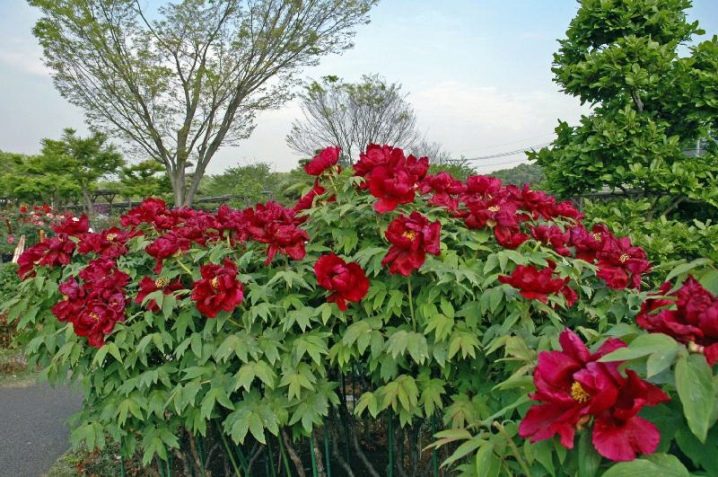
"Red Vis pink"
Variety "Red Vis pink" is a shrub up to 120 cm high with large double wavy flowers. The cherry-red buds are covered with pale pink strokes, and all the flowers have their own unique color and are noticeably different from each other.
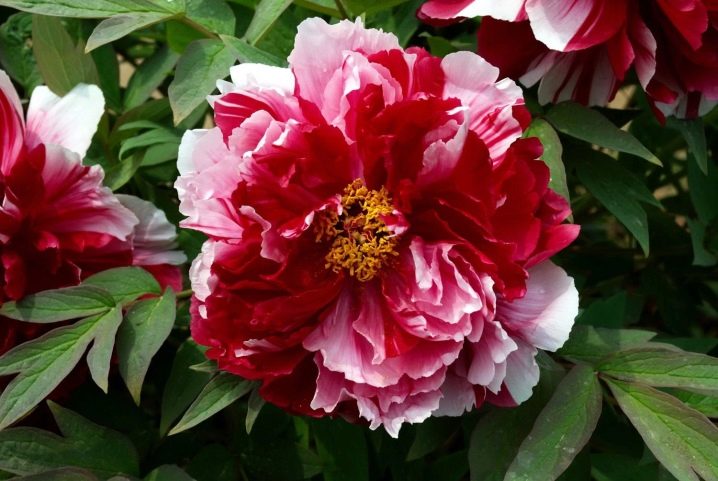
"The Qiao Sisters"
Peony "Sisters Kiao" is a rosy shrub with unusual flowers. The buds are not too large and densely dot the entire bush. One side of their petals is colored milky white and pale pink, while the other is red and crimson. At the same time, the core of the flower is golden yellow, which, in combination with two-color petals, looks very elegant. The variety is characterized by a fairly abundant flowering and looks good in bouquets.
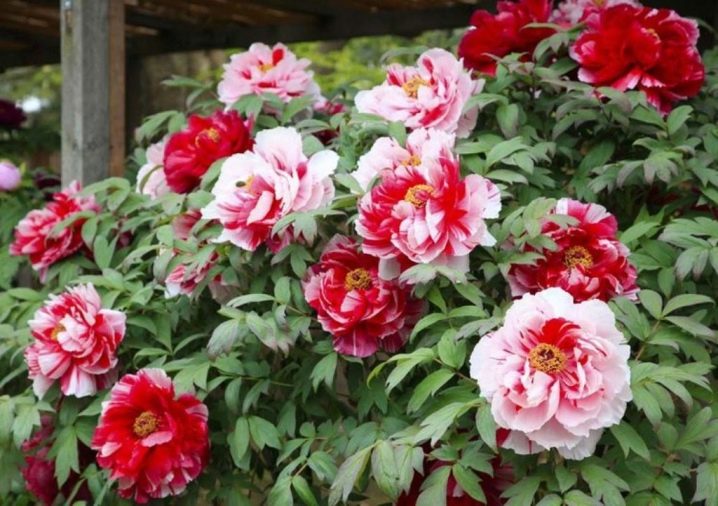
"Coral island"
Tree peony "Coral Island" is a deciduous shrub that grows in height and width up to one and a half meters. Crowned flowers are light red and reach 15 cm in diameter. The flowering is very abundant and occurs in the middle of the season.
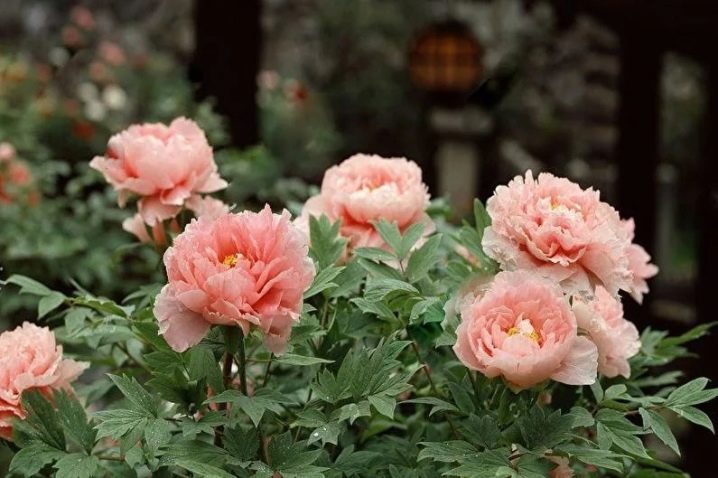
"Yaos Yellow"
Peony "Yaos Yellow" is a medium-flowering variety and is a spectacular decoration for flower beds and flower beds. It blends well with other flowering plants and looks great in group compositions. The plant has double flowers of a light yellow hue and is distinguished by abundant, not too long flowering.
The bush grows very quickly, does not tolerate cold very well and requires winter shelter with spruce branches or burlap.
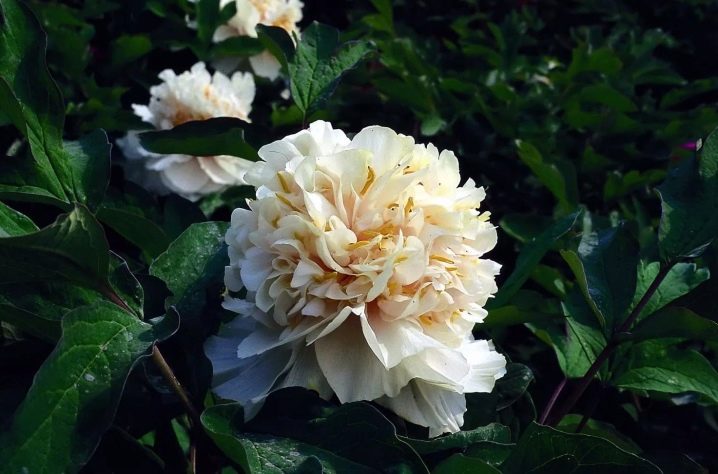
"Pink River"
The tree-like peony "Pink River" is distinguished by its pale pink, lotus-like buds and early flowering. The plant grows very vigorously, is absolutely undemanding to the soil and is quite resistant to diseases and pests.

"Pink Lotus"
The variety "Pink Lotus" is a medium-flowering tall shrub covered with lotus-shaped buds. The lacy petals are painted in pale pink and frame the core of black and golden stamens. The flower looks very impressive and differs noticeably against the background of pink-like counterparts.

"Peach in the Snow"
The tree variety "Peach in the Snow" is represented by a medium-sized shrub, reaching 120 cm. Flowering begins in the middle of the season and lasts for two weeks. The variety looks good both as part of compositions in a flower bed and in bouquets.

How to plant?
Before you start planting a tree peony, you should choose the right place. The plant does not like long-term shading and prefers open and well-lit areas. This should be taken into account when planting a flower in the garden, where the crowns of tall trees will create a constant shade. The best place for a flower is a hill protected from wind and drafts or a flat area, since it is not recommended to plant a plant in lowlands and pits.
The best time for planting is considered the end of August and the beginning of September. A plant planted during this period manages to root well before the onset of frost and make a supply of essential nutrients.
It is also possible to plant a peony in spring, however, due to the activation during this period of rapid growth and flowering, it does not adapt well to a new place.
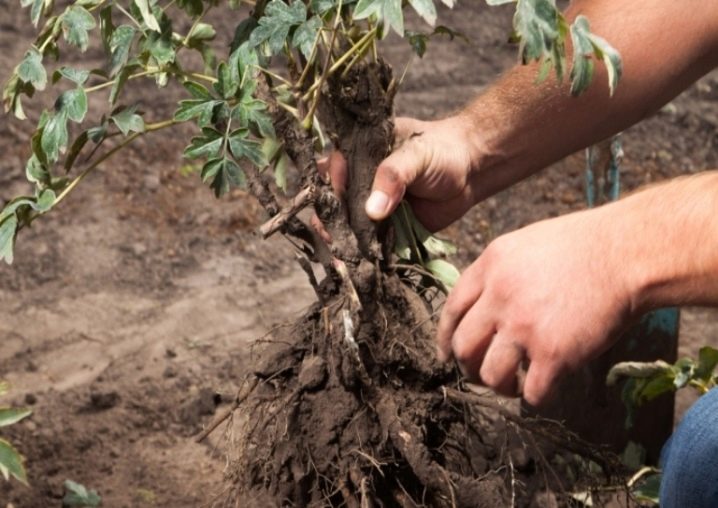
If the seedling was purchased at the end of autumn or in winter, then it is planted in a small pot filled with nutritious earth mixture, and removed to a lighted, not too hot room. During the winter, spring and half of the summer, the peony will strengthen its root system and at the beginning of September it will be ready for transplanting into open ground. In regions with a sharply continental climate, for example, in the Urals and Siberia, planting is performed in the second half of August, before the arrival of cold weather.
Another important step in preparing a plant for planting is soil selection. The tree peony prefers loamy soil and does not grow well on sand. Therefore, if the site contains mostly sandy soil, then it is advisable to add a mixture of clay, peat, turf and leaf humus, taken in equal proportions, to the flower bed.
If the soil on the site is highly acidic, then it is recommended to add a little lime.
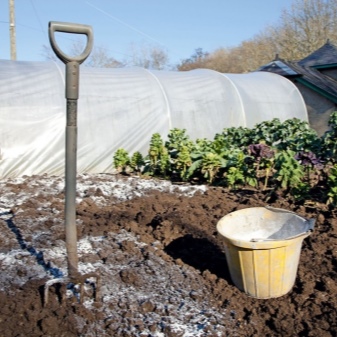
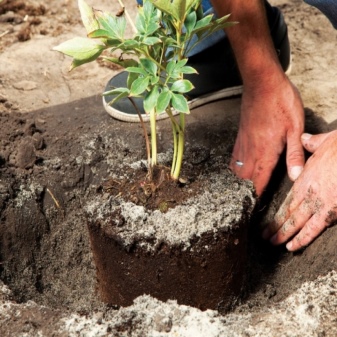
The process of planting peonies is quite simple and is as follows: in the selected area, a hole is dug with a depth of 70 cm and the same diameter. A drainage layer 30 cm thick is laid out at the bottom, using crushed stone, gravel or river pebbles for this. Then the drainage is sprinkled with earth and a bush is placed there. The roots are gently straightened and spilled abundantly with not too cold water. After all the liquid has gone into the drainage, soil is poured on the sides and tamped well. The seedling is buried to such a level that the root collar is flush with the ground.
Experienced gardeners believe that the pit for the peony must stand, and it is recommended to dig it out a month before planting. They recommend not to mix all the components of the substrate, but to lay them in layers. Immediately on top of the drainage, humus is laid in the first layer, then sod land and a little peat on top. Then add complex additives and a tablespoon of copper sulfate. With a strong acidity of the soil, peat is not added, but do not forget to put lime.
When planting several bushes at once, the distance between two adjacent ones should be at least 1.5-2 meters. This is due to the fact that peonies can grow in one place for more than 50 years, during which they will grow strongly and require a lot of space.
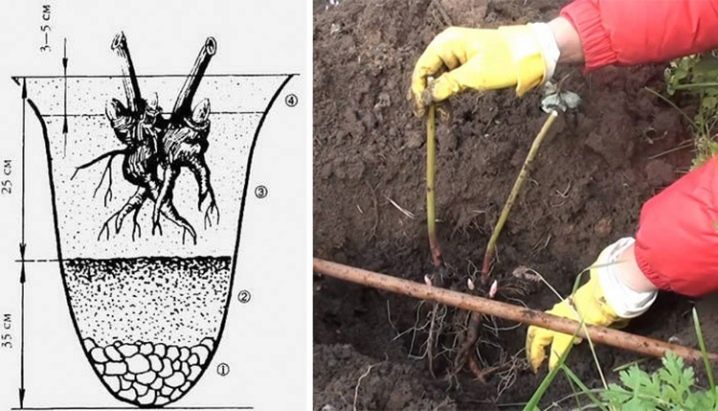
How to care?
Growing tree peonies is not difficult even for novice gardeners. The plant is quite unpretentious and does not require the creation of any special conditions. Bush care includes timely watering, regular feeding, sanitary pruning and, if necessary, replanting.
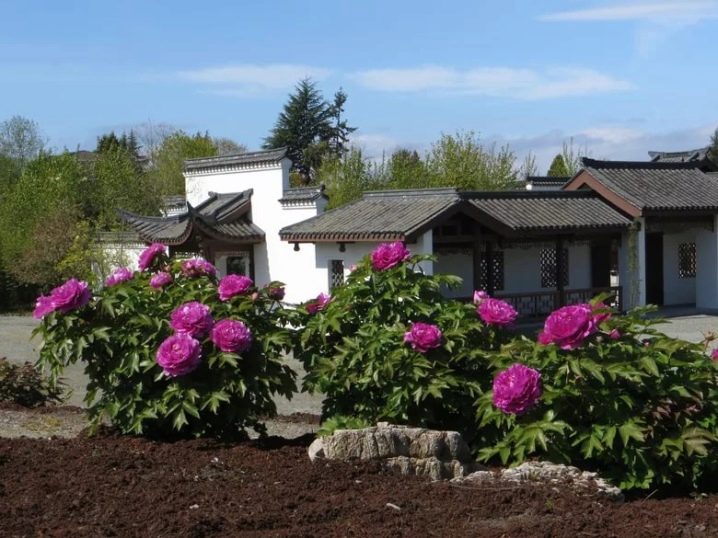
Watering
Summer watering regime for tree peonies is no different from the regime for moisturizing their herbaceous counterparts and is carried out every 2 weeks. 6-7 liters of water are poured under each flower, and when the weather is too hot and dry, the frequency and volume of watering is increased, focusing on the state of the plant and the degree of soil moisture. From the beginning of August, watering is gradually reduced, and during September it is completely reduced to nothing.
After each procedure, the moist soil within a radius of 0.5 m from the bush is carefully loosened and weeds are removed from it.
It is necessary to loosen the earth to a depth of at least 5 cm, after which it is imperative to sprinkle it with mulch.

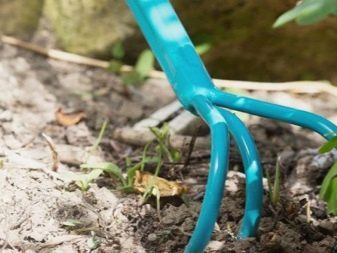
Top dressing
Tree peonies are very responsive to fertilization and are especially fond of nitrogen and potassium. In this case, nitrogen-containing complexes are introduced at the initial stage of the growing season, before flowering. As soon as the flower begins to form buds, the application of nitrogen is stopped and the main emphasis is placed on phosphorus and potassium. Preparations with their high content are applied before the end of the growing season. Adult peonies are fertilized by the root method, introducing mineral solutions under the root of the bush.
The plant is preliminarily watered abundantly, thereby protecting the root system from possible burns. Young individuals who have not reached the age of three are fed by the foliar method, diluting 30 g of mineral additives in 10 liters of water and spraying the bush from a finely dispersed spray bottle. Irrigation is performed immediately after watering the flower, no more than twice a month.
In August, feeding is stopped and the plant begins to prepare for the period of winter dormancy.
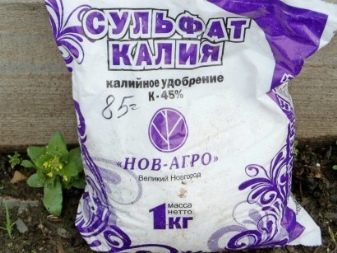

Pruning
Pruning is mandatory and purely sanitary. As a result of the procedure, the plant gets rid of dry, rotten and damaged shoots and visibly rejuvenates. Experienced Chinese gardeners once every 20 years, it is recommended to completely cut the bush almost to the root. This allows you to completely rejuvenate the peony and awaken the numerous adventitious buds located at the base of the stem.
Pruning is done in early spring before the plant begins to actively grow green mass. At the same time, dried stems are cut off at the very base, and 10 cm are left from healthy, but old shoots.Moreover, if you cut the stems to the upper axillary buds, then the next year the bush will delight you with very abundant flowering.
If, during pruning, frozen branches were found, then you should not rush to remove them: such shoots often leave, wake up and release buds.
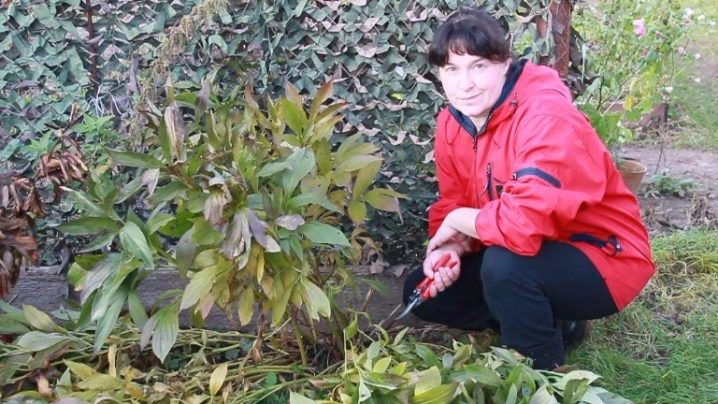
Transfer
Tree peonies react very badly to transplantation, and therefore it can be performed only in exceptional cases, for example, when redeveloping a garden plot or to free up space for construction. The transplanted plant does not adapt well to new conditions and is sick for a long time. During transplantation, the plant is very carefully removed from the ground along with an earthen lump, after which the soil is washed off the roots under an average stream of water. Further, the root processes are carefully examined for damage: rotten and injured roots are cut off, and too long are shortened.
Places of cuts are sprinkled with crushed charcoal or treated with a pink solution of potassium permanganate. Overgrown peonies are divided into several separate plants, separating the bush at the root collar. Moreover, each of the divisions should have several strong root processes and replacement buds. Before planting flowers in a new place, their roots are immersed for 30 minutes in a clay chatterbox, after which they are carefully placed in the holes and sprinkled with earth.

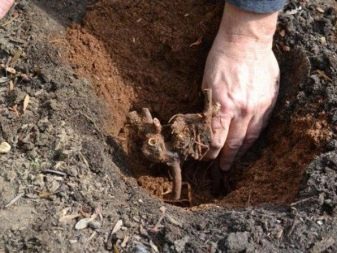
Reproduction
Tree peonies are propagated using seeds, dividing the bush, cuttings and lateral layers.
Seed method
It will take quite a long time to grow a peony from a seed. Usually, at least 5 years pass from the moment of sowing to the appearance of the first flowers. Because of this, this method is practically not used by amateur gardeners and is more often used in breeding work to obtain new varieties. The duration of the process is largely due to the special structure of the seeds, which have a dense shell and sprout no earlier than a year later.
To accelerate germination, scarification is often performed, which consists in filing the casing with a file.
However, this procedure requires a steady hand and some experience, since otherwise you can damage the cotyledons and destroy the seed.
After scarification, the seeds are planted in loose fertile soil to a depth of 2-3 cm, moistened and removed to a warm, bright place. Before the first shoots appear, the soil is systematically moistened with soft settled water, using a fine-dispersion spray gun for this. However, the germination process of seeds can be accelerated without the use of scarification techniques. To do this, in the autumn, peony seeds are sown in shallow containers filled with a nutrient mixture and exposed to frost.
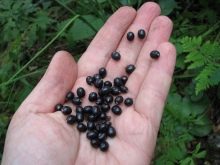
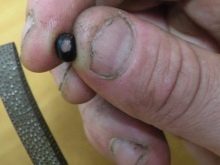
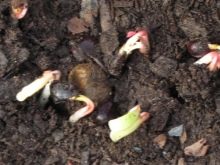
In March, crops are brought into an apartment and placed at a temperature of at least 20-22 degrees. Due to the extreme cold and temperature changes, seeds germinate much faster. If everything was done correctly, then the first shoots appear in the spring, however, some seeds will be able to germinate next year. During the summer months, young peonies should be grown like any other garden flower, with regular watering and small amounts of fertilizer. In the first days of autumn, shoots are transplanted from containers into open ground at a distance of 1.5 meters from each other.
Approximately in the third year of life, full-fledged foliage appears on a young sprout, and after a couple of years the peony will give its first flowers.
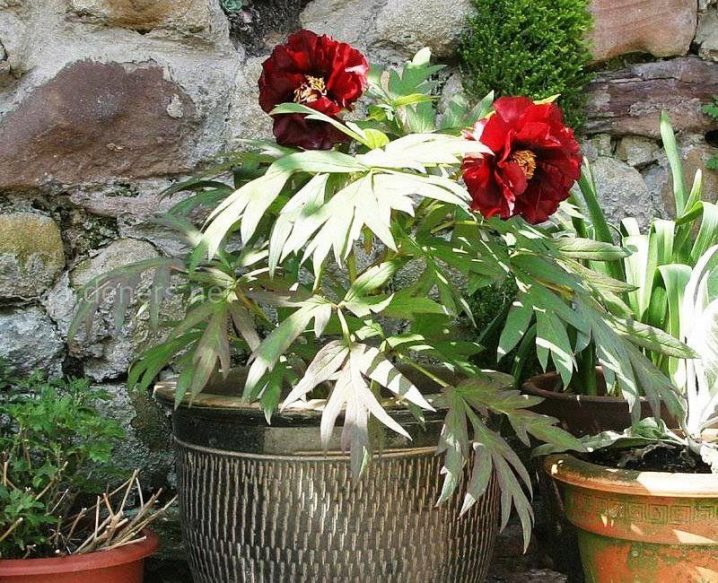
However, with the seed method of breeding, you need to be prepared for the fact that the resulting plant may not inherit all the varietal characteristics of the parent individual or partially retain them.
Therefore, the process of growing peonies from seeds is more creative than practical., since before the first flowering, it is not completely clear what will grow from the seeds.
Reproduction by layering
This method is very simple and effective and consists in the following: in the lower part of the bush, a not too thick shoot is chosen, it is slightly incised and bent to the ground. The place of the incision is sprinkled with earth, and the stem itself is fixed in this position with a wire or hairpin. Further escape moisturize regularly and after the appearance of root processes separated from the mother and put in a separate place.
Some gardeners recommend do not cover the incision with earth, but wrap it with sphagnum moss and wrap it with plastic wrap. The moss is also kept moist and removed after the first roots appear.
The layering procedure is recommended in May. Over the summer, the roots have time to grow well and at the beginning of autumn the shoot is also separated from the mother plant and planted.
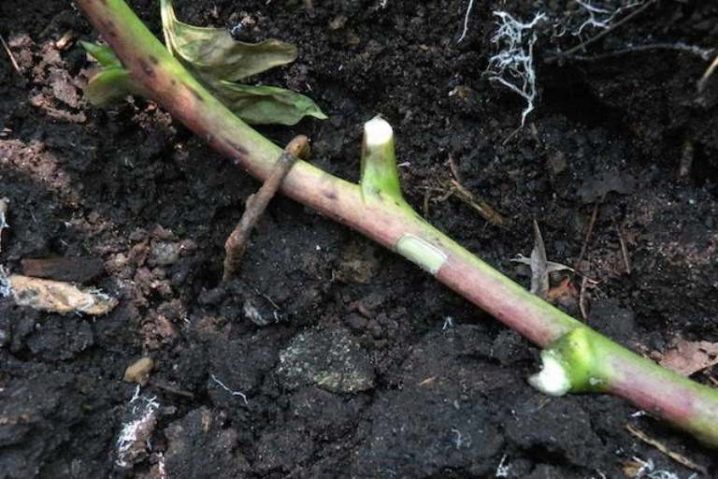
Cuttings
This method is most often used by gardeners and is highly effective. To do this, in the first half of summer, a semi-lignified stem is taken and a stalk with two large buds and a leaf is cut from it. Then the container is filled with a mixture of peat and river sand, taken in equal proportions, and the petiole is planted in it, deepening it no more than 1.5-2 cm. The sprout is covered with a glass jar and placed in a warm, well-lit place. Every day, the jar is briefly cleaned and the escape is aired.
The substrate is moistened with a sprayer, keeping it moist at all times... Rooting occurs quite quickly, and after a month and a half, young leaves appear on the shoot. In the second half of September, the sprouts are planted in separate pots and grown in indoor or greenhouse conditions until spring. With the onset of warmth, as soon as the soil warms up to 10 degrees, young peonies are transplanted into open ground.
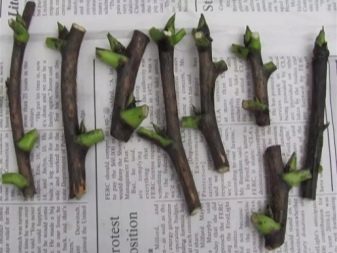
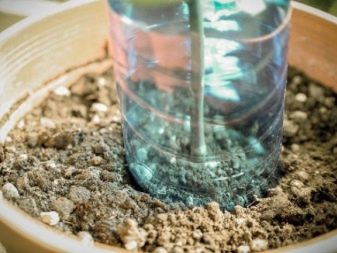
Graft
This method is also often used by both amateur and professional gardeners and is as follows: in early August, a strong stalk with two or three buds is cut from an adult peony and sharpened from below. Then an incision is made in the pre-selected part of the root and the scion is inserted into it.
The joint is tightly wrapped with garden or grafting tape and the "structure" is placed in a plastic bucket with wet sawdust. From above, the container is covered with a transparent film and removed in partial shade. A month later, the grafted rhizome is planted in a container, placing a peephole at a depth of 5-7 cm, and removed to the greenhouse.
It usually takes about 2 years to grow a peony in this way.
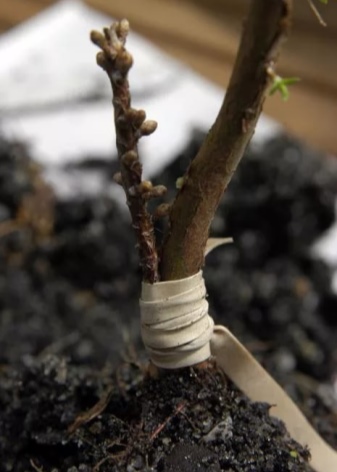
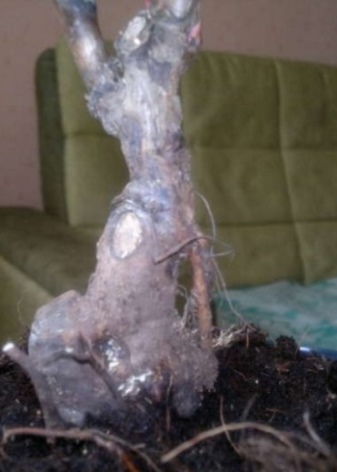
Preparing for winter
Despite the high frost-resistant characteristics of tree peonies, they are still sheltered for the winter. This is due to the fact that during the thaw period, the buds wake up and the bush begins to grow. Then frost sets in and the revived buds freeze and die. To prevent this from happening, at the end of October, the stems of the bush are tied, and the trunk circle is mulched with peat. After about a month, with the onset of a stable minus, the bush is covered, constructing a hut of spruce branches and dry foliage over it.
If frosts are combined with a strong wind, then the plant is additionally covered with jute bags, lutrasil or spunbond.
However, you need to be more careful with non-woven materials, and immediately remove them when the first thaws come. Otherwise, the bush will begin to rot and may get sick with a fungal infection.
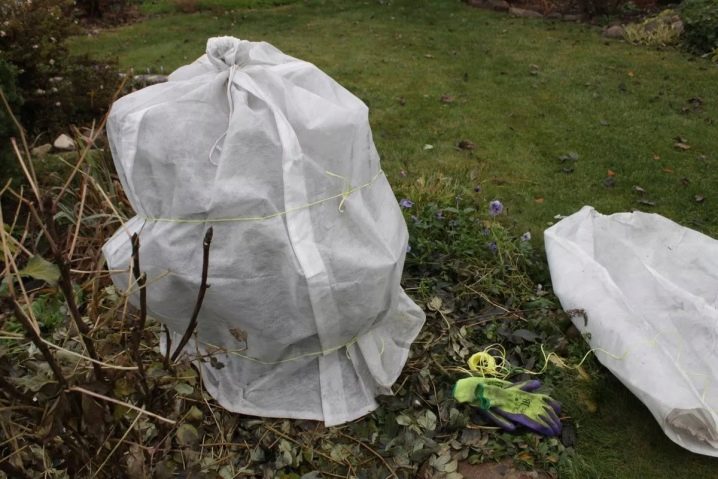
Diseases and pests
In general, the tree peony is a sturdy plant and has good resistance to many ailments. Therefore, most flower problems are caused by mistakes in care and poor growing conditions. Below are the most common ones, as well as possible causes of their occurrence and methods of elimination.
Gray rot
If a grayish bloom appeared on the leaves of the peony, and the young and strong stems began to wither and soften sharply, then the matter is most likely in the appearance of gray rot - a dangerous fungal disease. The disease appears as a result of an excess of humidity against the background of a lack of sunlight and heat and is characteristic of a damp and cold summer.
Treatment consists in reducing watering and irrigating the bush and the periosteal circle with a solution of potassium permanganate (4 g / 10 l) or copper sulfate.
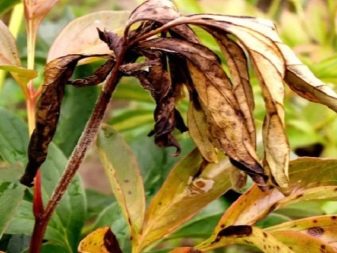

Ring mosaic
The appearance of stripes and rings on the leaf blades of a peony indicates the onset of a viral disease - a ring-shaped mosaic. The lesions are yellow or greenish in color and bring more trouble from an aesthetic point of view: the disease does not greatly affect the growth and development of the bush, but it can spoil its decorative appearance. The stripes and rings begin to dry out and crack over time, giving the peony an unhealthy and unkempt look.
A way out of the situation is to spray the plant with a contact fungicide "Maxim", diluted according to the instructions on the package.
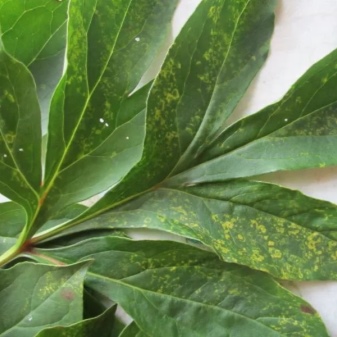
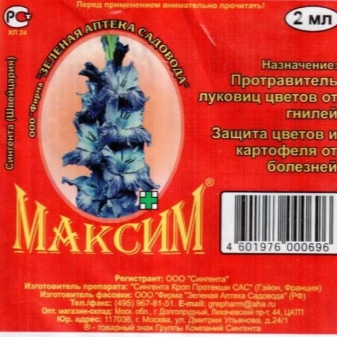
Rust
The appearance of rust is dangerous for the plant in that the bush is affected quite quickly and all foliage can dry out in almost a couple of days. The first signs of the disease are brownish-purple spots, after which the leaf blades quickly curl and dry out. The causes of the disease are often too thick plant density and poor ventilation of the bush.
Treatment consists in the immediate removal of infected parts and their destruction. As a preventive measure, it is recommended to timely loosen the soil near the bush, remove the weeds growing nearby and thin out neighboring plants. Also, in early spring, before the first leaves appear, it is recommended to treat the ground around the peony with a nitrophene solution, diluting 200 g of the drug in 10 liters of water.
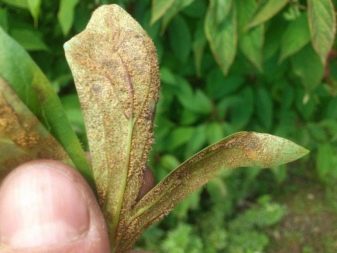
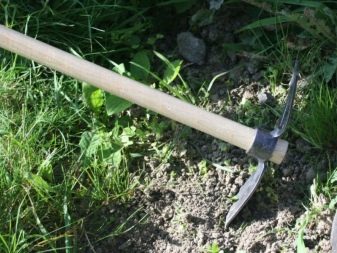
Of the pests, aphids and leafworm caterpillars attack the tree peony more often than others. To destroy aphids, the bush is sprayed any of the available pyrethroids, and in case of an invasion of caterpillars, chlorophos.
Reviews
Florists speak very well of the tree peony and often plant it in their summer cottages and backyards. The high decorative qualities of the bushes and their undemanding care are noted. Of the minuses, attention is drawn to difficulties in transplanting a plant, after which individuals often die or get sick for a long time.
In addition, many, especially novice gardeners, complain about the ineffectiveness of some breeding methods. For example, they complain that even the freshest, freshly harvested seeds do not always germinate, and despite proper care, they simply lie in the ground. In general, there are much more positive reviews about peony than negative ones. Summer residents are very fond of this beautiful plant and are happy to grow it for many years.
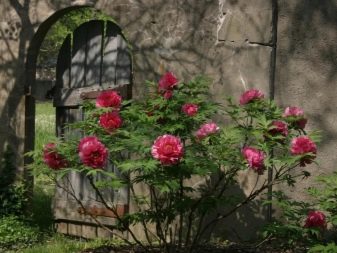

An overview of the Tree Pepny tree peony awaits you in the video below.







































































































The comment was sent successfully.